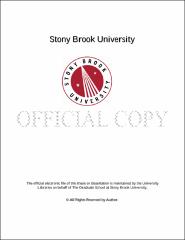| dc.identifier.uri | http://hdl.handle.net/11401/76272 | |
| dc.description.sponsorship | This work is sponsored by the Stony Brook University Graduate School in compliance with the requirements for completion of degree. | en_US |
| dc.format | Monograph | |
| dc.format.medium | Electronic Resource | en_US |
| dc.language.iso | en_US | |
| dc.publisher | The Graduate School, Stony Brook University: Stony Brook, NY. | |
| dc.type | Dissertation | |
| dcterms.abstract | Superconducting materials are promising for future applications on energy transport and storage. The key properties for superconductors are critical temperature Tc, critical current density Jc and upper critical field Hc2. In this dissertation, detailed transport studies were performed on two superconducting materials: FeSe0.5Te0.5 thin films and the second generation YBa2Cu3O7-δ coated conductors, in order to determine what limits the broad applications of these superconductors. High quality of FeSe0.5Te0.5 thin films were grown by pulsed laser deposition. Low temperature oxygen annealing and proton irradiation were conducted on the films, as the post-treatment techniques in order to improve the transport performance. Jc at self-field was doubled, reaching ~3 MA/cm2 in oxygen annealed films. An overall enhancement of in-field Jc was observed as well. An even greater enhanced Jc at high field was achieved in proton irradiated films, simultaneously with a Tc enhancement, rather than the degradation commonly found after irradiation in cuprate superconductors. The enhancement of the irreversibility field and upper critical filed is also observed in the irradiated films. Low temperature oxygen annealing and proton irradiation are both controllable and cost-efficient ways to enhance the Jc performance of FeSe0.5Te0.5 thin films, making this class of material very promising in potential high field applications. Gold ion irradiation was performed on second generation YBa2Cu3O7-δ coated conductors. At the optimized dosage of 2 × 10^11 cm-2, Jc performance under the field of 3 T was significantly enhanced by 70%, 98% and 64% at 5 K, 30 K and 77 K, respectively. Though reduced after irradiation, Tc and self-field Jc in the samples can be effectively recovered by post-oxygen annealing. Jc at 77 K can also be further enhanced by post-oxygen annealing for samples irradiated at certain dosages. This ion irradiation technique is now developed into the reel-to-reel method for high performance mass produced second generation coated conductors. | |
| dcterms.abstract | Superconducting materials are promising for future applications on energy transport and storage. The key properties for superconductors are critical temperature Tc, critical current density Jc and upper critical field Hc2. In this dissertation, detailed transport studies were performed on two superconducting materials: FeSe0.5Te0.5 thin films and the second generation YBa2Cu3O7-δ coated conductors, in order to determine what limits the broad applications of these superconductors. High quality of FeSe0.5Te0.5 thin films were grown by pulsed laser deposition. Low temperature oxygen annealing and proton irradiation were conducted on the films, as the post-treatment techniques in order to improve the transport performance. Jc at self-field was doubled, reaching ~3 MA/cm2 in oxygen annealed films. An overall enhancement of in-field Jc was observed as well. An even greater enhanced Jc at high field was achieved in proton irradiated films, simultaneously with a Tc enhancement, rather than the degradation commonly found after irradiation in cuprate superconductors. The enhancement of the irreversibility field and upper critical filed is also observed in the irradiated films. Low temperature oxygen annealing and proton irradiation are both controllable and cost-efficient ways to enhance the Jc performance of FeSe0.5Te0.5 thin films, making this class of material very promising in potential high field applications. Gold ion irradiation was performed on second generation YBa2Cu3O7-δ coated conductors. At the optimized dosage of 2 × 10^11 cm-2, Jc performance under the field of 3 T was significantly enhanced by 70%, 98% and 64% at 5 K, 30 K and 77 K, respectively. Though reduced after irradiation, Tc and self-field Jc in the samples can be effectively recovered by post-oxygen annealing. Jc at 77 K can also be further enhanced by post-oxygen annealing for samples irradiated at certain dosages. This ion irradiation technique is now developed into the reel-to-reel method for high performance mass produced second generation coated conductors. | |
| dcterms.available | 2017-09-20T16:49:53Z | |
| dcterms.contributor | Gersappe, Dilip | en_US |
| dcterms.contributor | Li, Qiang | en_US |
| dcterms.contributor | Gu, Genda | en_US |
| dcterms.contributor | Wu, Jie. | en_US |
| dcterms.creator | Zhang, Cheng | |
| dcterms.dateAccepted | 2017-09-20T16:49:53Z | |
| dcterms.dateSubmitted | 2017-09-20T16:49:53Z | |
| dcterms.description | Department of Materials Science and Engineering | en_US |
| dcterms.extent | 125 pg. | en_US |
| dcterms.format | Application/PDF | en_US |
| dcterms.format | Monograph | |
| dcterms.identifier | http://hdl.handle.net/11401/76272 | |
| dcterms.issued | 2016-12-01 | |
| dcterms.language | en_US | |
| dcterms.provenance | Made available in DSpace on 2017-09-20T16:49:53Z (GMT). No. of bitstreams: 1
Zhang_grad.sunysb_0771E_12994.pdf: 5311202 bytes, checksum: e181611cf2156186987f344d6299e651 (MD5)
Previous issue date: 1 | en |
| dcterms.publisher | The Graduate School, Stony Brook University: Stony Brook, NY. | |
| dcterms.subject | Materials Science | |
| dcterms.subject | Coated Conductor, Critical Current, FST, Supercondcutor, Thin Film, YBCO | |
| dcterms.title | Transport Studies of Superconducting Materials | |
| dcterms.type | Dissertation | |

